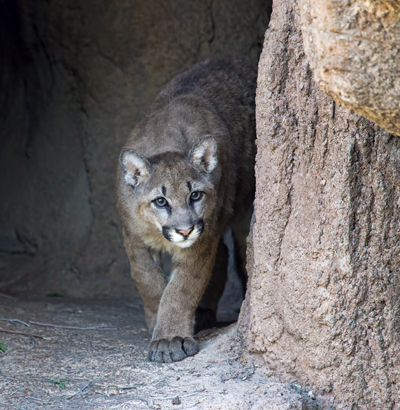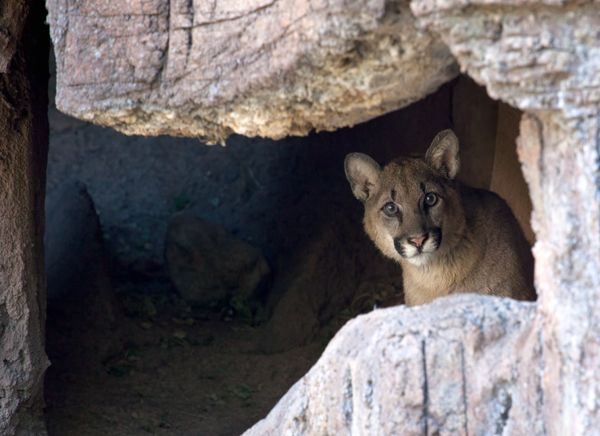Desert Museum Offers New Home to Rescued California Mountain Lion Cub
August 2013
The Desert Museum has adopted a new mountain lion cub that was rescued earlier this year in California. On the evening of March 9, 2013, wildlife officers from the California Department of Fish and Wildlife (CDFW), local animal control officers, and the San Jose police department responded to a call in San Jose, CA. A young, 15-lb mountain lion was observed in hiding in the backyard shrubs of a residential neighborhood.
With the assistance of Wildlife Emergency Services (WES), CDFW successfully captured the cub and transported it to the Wildlife Center of Silicon Valley (WCSV) where the cub was sedated and examined. Although the cub was bright, alert and responsive at the time of capture, it was in poor body condition (underweight) had a heavy flea and tick infestation, and was very dehydrated. After giving the cub fluids and applying flea control, the cub was moved to a secure area and allowed to rest overnight.
On March 10, 2013, the cub was transported to CDFW's Wildlife Investigations Laboratory (WIL) in Rancho Cordova, CA where it received additional treatments that included fluids, antibiotics, dewormer, and tick treatment. Further diagnostic testing was performed including a complete blood panel, feline leukemia/feline immunodeficiency virus test, and a fecal exam. While its blood work was normal and the disease testing was negative, the cub was closely monitored by WIL veterinarians and staff for the next few weeks for signs of illness. At this time it was inconclusive why this little cub was orphaned — and it was possible that its mother had been killed. But it could have also been abandoned if its health was compromised.
WIL staff carefully reintroduced the underweight cub to appropriate foods and, with the help of the Folsom Zoo, designed a balanced diet that would satisfy the nutritional needs for the growing cub. To keep the cub physically active, a variety of toys were introduced to encourage the cub's curiosity and to give provide many opportunities for play.
WIL contacted the Arizona-Sonora Desert Museum, which expressed interest in providing a permanent home for this special cub. Once the cub was deemed healthy enough to travel and approvals for its placement were granted by both states' wildlife agencies, the cub was transported by WIL staff to Blythe, California. The cub was transferred into the care of the Arizona-Sonoran Desert Museum staff early in the morning of April 15, 2013.
At that time, Desert Museum staff brought the cub to the Museum's grounds and installed the cub into the nighttime holding area of the Mountain Woodland Mountain Lion habitat. The cub remained in quarantine, monitored by Desert Museum staff and veterinarians. At this time, Museum staff began initial training activities to accustom the cub to keepers and respond to cues while awaiting completion of the quarantine period.

Photo by Rhonda Spencer
The Desert Museum traditionally adopts orphaned mountain lions, which have not been suitable for release into the wild, including the Museum's newest addition, a five and a half-month-old male cub found in San Jose, CA in March weighing only 15 lbs. Rescued and nursed back to health by the California Department of Fish and Wildlife, but unsuitable for reintroduction into the wild, its adoption by the Desert Museum was arranged through the Arizona Game and Fish Department.
Initial training consists of teaching the animal to respond to keepers' cues to safely move from one area to another upon request. All training is conducted with positive reinforcement techniques. "He is thriving," relates Riplog-Peterson "and we are pleased now to share him with visitors who will appreciate his energy and youthful curiosity."
After delighting visitors for over 13 years, the Desert Museum recently retired its two aging mountain lion siblings. "The mountain lions previously in the exhibit needed a residence which could better suit their physical limitations brought on by arthritis," states Craig Ivanyi, Executive Director. "A new behind-the-scenes habitat has been designed where the lions will spend their much deserved retirement years." Each sibling was weighed and received a full health evaluation prior to retirement. Mountain lions in the wild have an average life expectancy of thirteen years.
The mountain lions' retirement area is not open to the public. The new habitat offers comfortable and safe surroundings, where animal keepers can provide a variety of enrichment options to keep them psychologically engaged. The new quarters include a resting platform and indoor/outdoor areas with cooling and heating systems when needed. The retired animals are 13+ years old.
Known scientifically as Puma concolor, mountain lions (a.k.a. pumas or cougars) are the largest of the small cats. Even though they are referred to as lions, they lack the ability to roar. They are consummate predators, with a small head, muscular body, powerful shoulders, strong legs, large paws, and a long tail. Cougars have powerful claws and jaws armed with impressive canines. They are stalking, ambush hunters that normally live solitary lives.

Photo by Rhonda Spencer